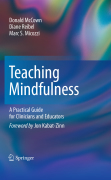
Teaching mindfulness: a practical guide for clinicians and educators
McCown, Donald
Reibel, Diane
Micozzi, Marc S.
This is a rigorous, systematic guide for the professional development of mindfulness practitioners across the range of professional clinical settings. It is also a hands-on text covering both the academic theory and the concrete skills required in teaching mindfulness to groups and individuals. Part 1: Responding to Profound Needs situates the demand for meditation teachers within the context of the dramatic changes underway in our society, such as the high levels of stress and dissatisfaction in the workplace and daily life, the growth inpsychotherapeutic interventions based on mindfulness meditation, the expanding acceptance of complementary and alternative medicine, and the growing interest in personal spiritual practice both inside and outside of institutional religion. It looks next at who may be suitable to act as a teacher of applied meditation and how such individuals may react to the calling to teach. Finally, Part 1 attempts to define the essential qualities an applied meditation teacherwould possess, as well as the behaviors, attitudes, and skills such a teacherneeds to cultivate for professional success. Part 2: Applying Meditation presents a practical model of adult growth and change that synthesizes the insights of field anthropology, postmodern psychotherapy, transformative learning in adult education, and personal and executive coaching. This model is used as the basis for presenting and exploring the characteristics and skills the applied meditation practitioner must bring to encounters with students in various phases of growth and change. Approaches to teaching and development of curriculafor groups and individuals flow naturally from these discussions, as do discussions of how to find and work with a practitioner. Part 2 is the core of the book. It is in these chapters that practitioners will recognize their own strengths and weaknesses. Part 3: Learning and Practicing presents valuable opinions and advice from a range of recognized experts on different facets of instruction in and working with meditation as an applied skill. These independent essays are essential teachings in their own right, while helping to define a wider scope of resources for further inquiry—made actionable in Part 4. These essays will give the book an authority and appeal that a single author could not provide. Part 4: Exploring Further is an exhaustive resource, with an annotated bibliography on applied meditation; a listing of the emerging courses, institutions, and certification opportunities that may assist development of objective credentials for the applied meditation practitioner; and a listing of resources for practitioners’ personal development." The first academic text on mindfulness across a broad range of professional clinical settings Written from asensitive secular perspective that acknowledges the Buddhist roots of the practice, as well as the full range of theistic and non-theistic traditions, withattention to the Jewish and Christian practices that are a central part of the authors’ identities INDICE: Part 1: Responding to profound needs. 1. The unstable ground of our practice and relationships. 2. The calling to share and be transformed. 3. Who has the courage to do this? 4. Authority, authenticity, and friendship—the essentials. 5. Behaviors, attitudes, modes of being, and skills—the prerequisites.- Part 2: Applying meditation. 6. Defining and using a four-phase model ofadult growth and change. 7. Phase 1: Assuaging anguish through authentic presence. 8. Phase 2: Improving understanding through authority based on objectivecompetencies. 9. Phase 3: Providing guidance through authority based on internal competencies. 10. Phase 4: Assuaging suffering through authenticity and compassion as the life cycle ends and begins again. 11. The group context of applied meditation. 12. The individual relationship in applied meditation.- Part 3: Learning and practicing. 13. Beyond belief: the pragmatic position of applied meditation. 14. A regular life: daily practice and extended retreats for practitioner development. 15. Working within limits of competence and compassion—ethics for practitioners. 16. Who is asking 'Who am I?'—psychological typology for diagnosis and prescription. 17. The point of change—midlife and other crises as motivators for meditation. 18. Changing lives and lifestyles—meditative awareness in the personal care dimension. 19. Touching art—reading, listening, and viewing for challenge and change. 20. Language-ing—vocabulary and imagery in guiding meditation. 21. Bodies in motion—moving meditation as an integral practice. 22. The conscious entrepreneur—marketing yourself as an applied meditation teacher. 23. Beginning a friendship—finding a practitioner and developing a relationship.- Part 4: Exploring further resources. 24. A basic libraryfor applied meditation. 25. Training and certification opportunities. 26. Support for personal practice and retreats. 27. An emerging community. Index.
- ISBN: 978-0-387-09483-0
- Editorial: Springer
- Encuadernacion: Cartoné
- Páginas: 360
- Fecha Publicación: 01/01/2010
- Nº Volúmenes: 1
- Idioma: Inglés
